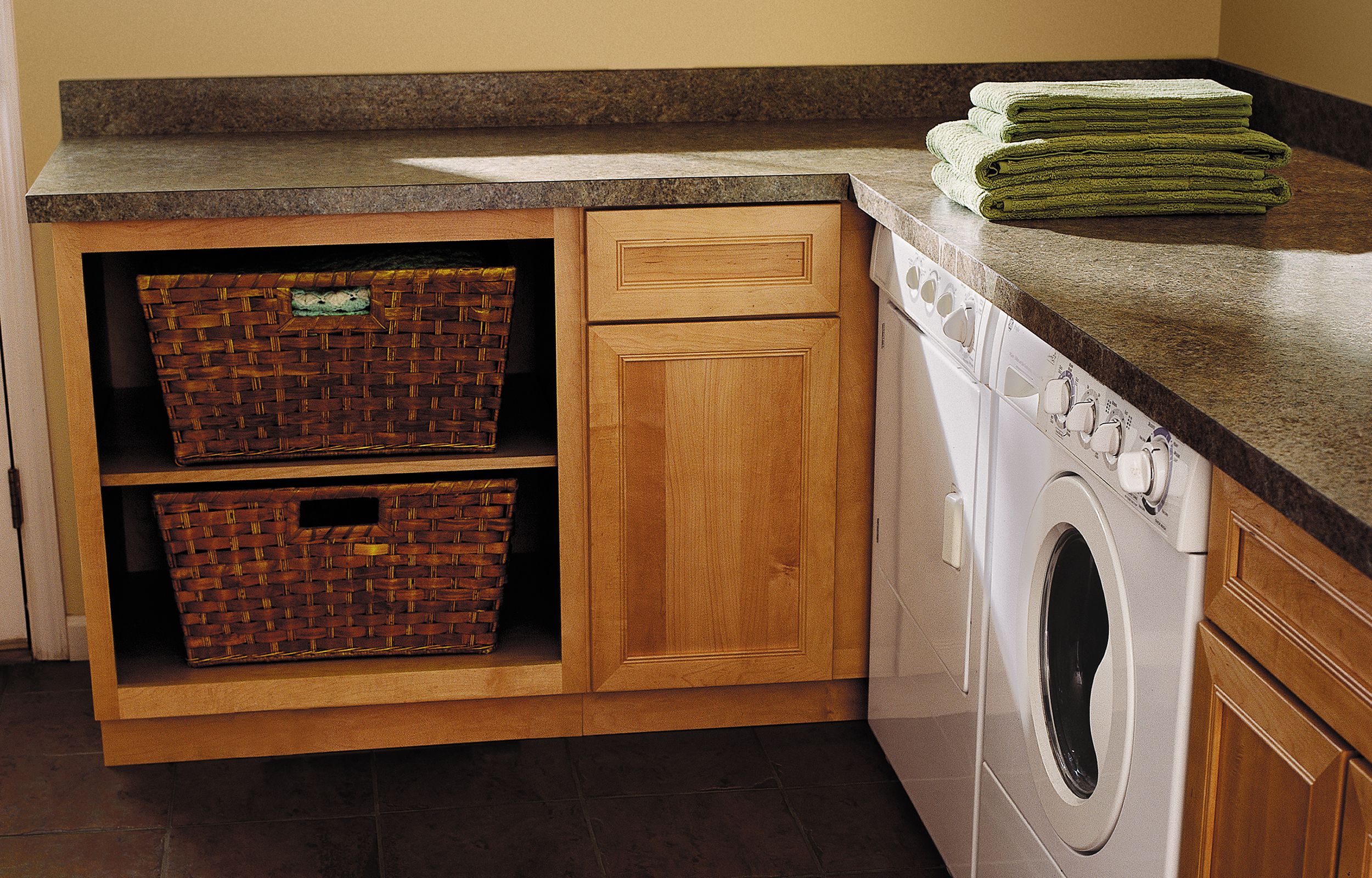Project details
Skill
Cost
Estimated Time
Laminating a countertop is an affordable and effective way to upgrade your kitchen or workspace. Laminate is easy to maintain and comes in hundreds of designs. It’s also lightweight, making it easier to work with during installation. It may not have the luxury appeal of natural stone, but it can can transform a worn-out surface into a sleek, durable countertop that withstands daily use. With the right tools and techniques, you can achieve professional-looking results in just under a day.
Tools and Materials Needed to Laminate a Countertop
Here’s what you’ll need to get started on your laminate countertop.
Tools
- Caulk gun
- Circular saw
- Drill/driver
- File
- J-roller
- Level
- Measuring tape
- Paint roller
- Trim router with laminate-cutting bit
Required Materials
- 1 1/4-inch and 1 5/8-inch screws
- Clear caulk
- Contact cement
- Laminate sheets
- Particleboard sheets
- Sandpaper (100-grit)
- Wood scraps or dowels
Preparing Your Workspace to Laminate
A clean and organized workspace is key for any do-it-yourself (DIY) project. Take the time to set up properly before starting.
Clear the Area
Remove all items from the existing countertop and surrounding areas. Cover nearby surfaces and floors to protect them from adhesive and debris. Make sure you have proper ventilation, as contact cement has strong fumes.
Set Up a Work Surface
Create a large, flat work surface to cut and prepare your laminate sheets. A pair of sawhorses with a sheet of plywood works well. Make sure you have enough space to handle large pieces of particleboard and laminate.
Build the Substrate
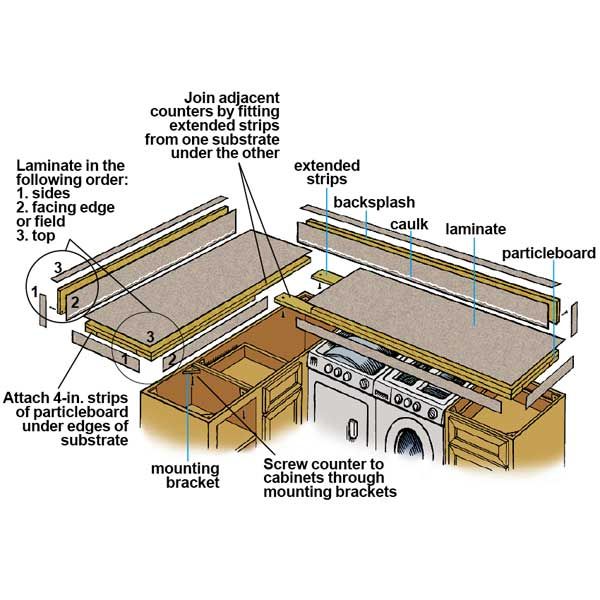
The substrate forms the foundation of your laminate countertop. A well-built substrate creates a smooth, stable surface to which the laminate can adhere.
Cut the Particleboard
Using a circular saw, cut a sheet of particleboard to fit your countertop, adding a 1-inch overhang to edges that aren’t abutting a wall.
Cut 4-inch strips of particleboard to line the underside of each edge. Glue and screw the strips to the sheet with 1 1/4-inch screws. Make sure the edges are perfectly flush. If you’ll be connecting two countertop sections, size and arrange the strips on one piece to extend beyond the sheet’s end and fit under the adjacent piece (see overview). Use shorter strips on the other piece to accept the extensions.
Dry-fit the countertop sections before laminating them to ensure the pieces fit tightly. Sand the seam with 100-grit paper to correct any mismatches. To make a super-tight seam between two particleboard pieces, back-cut the end of one piece by tilting your circular saw blade to 5 degrees.
Cut the Laminate
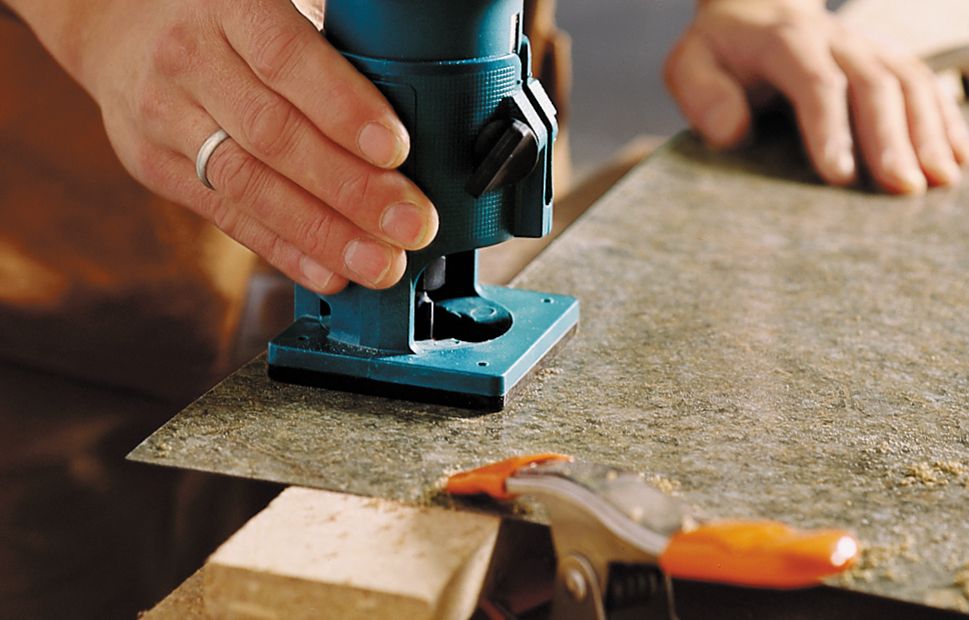
Carefully unroll the laminate and lay it on a flat surface, face up. Add 1 inch to the counter’s length and width and mark these dimensions on the face. Clamp the sheet to a straight length of lumber at each mark. Line the marks up with the lumber’s edge.
Using a trim router fitted with a laminate-cutting bit, cut the sheet along the mark. Use the lumber as a guide for the router bit. Always cut laminate good side facing up.
Mark out the side strips—2 1/2 inches wide and 1 inch longer than the sides—from the remaining pieces. Cut these strips with the keep piece off the lumber. Project the cutline 1/2-inch past the edge (to account for the router bit’s width).
When using a router, cut from left to right as you face the edge (and the tool is upright), to keep the bit from pulling.
Adhere the Side Pieces
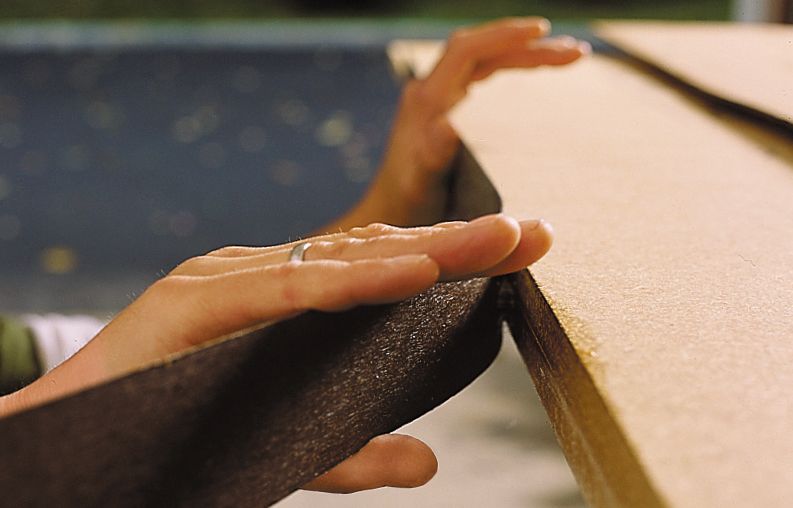
Using a chip brush, apply contact cement to the back of the laminate strips for the counter’s short sides and onto the substrate sides. Wait 15 minutes, then coat the sides again.
Allow the contact cement on both parts to dry to the touch. Take a strip and position it over the side without letting it touch, making sure it’s evenly aligned. Working from one end to the other, stick the laminate to the substrate, smoothing it as you go. Press the laminate firmly with several passes of a J-roller; be careful not to roll over the edge, which could snap the laminate.
Touch Up Uneven Edges
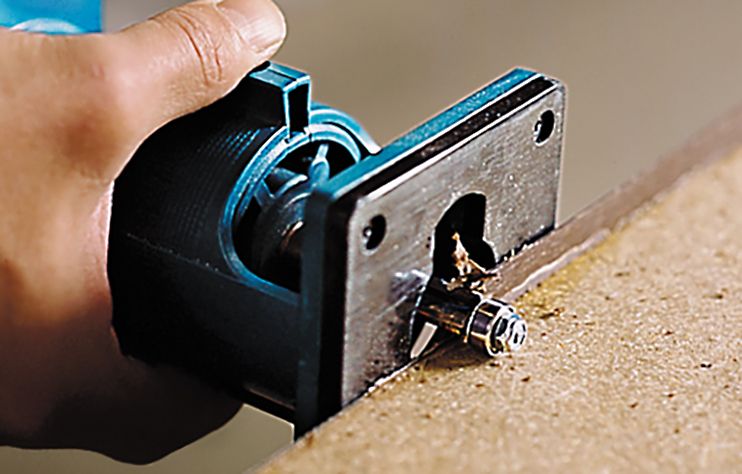
Using the router turned on its side, cut off the laminate’s overhanging edges, running the bit counterclockwise around the edges. Touch up uneven edges with a file or sander, keeping it flat on top of the particleboard and pushing away from the laminate. With the sides done, glue and trim the front edge.
Don’t let the router linger in one spot or it can burn the laminate. Keep the bit free of adhesive by occasionally unplugging the router and soaking the bit in water.
Cover Laminate Back and Substrate With Contact Cement
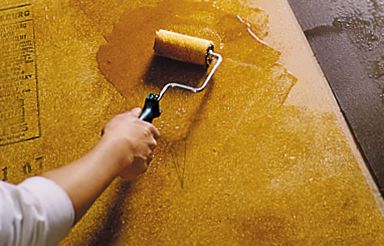
Turn the top laminate sheet facedown. Pour contact cement onto the back and spread the adhesive over the entire sheet using a paint roller. Roll any excess onto the substrate. Pour more contact cement onto the substrate and spread it out until it’s fully covered. The contact cement should be dry to the touch on both parts.
Laminate the Top
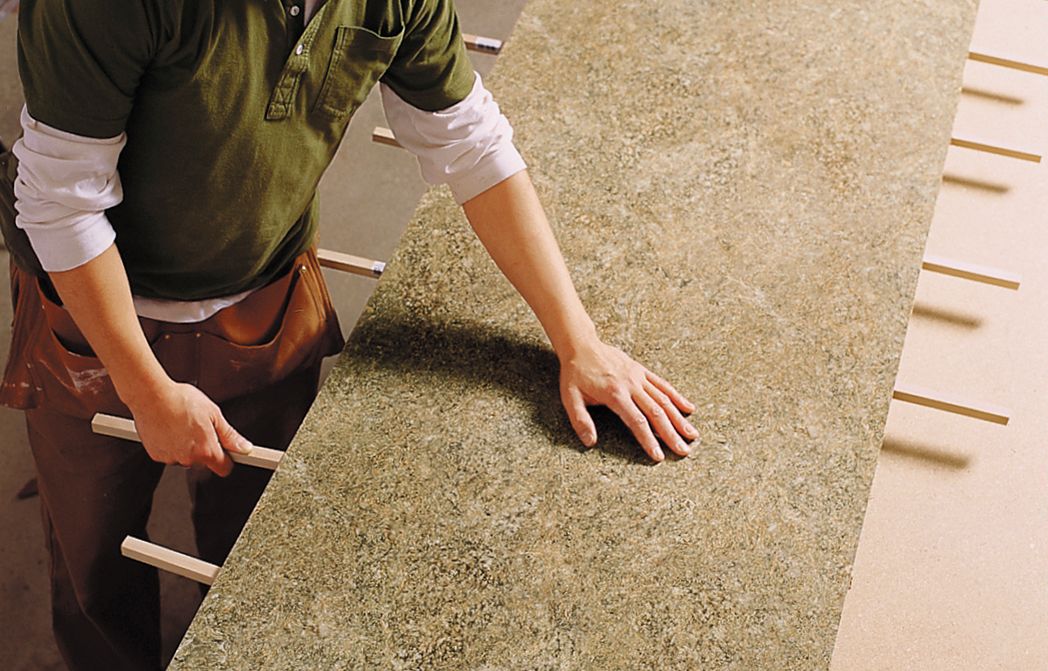
Lay wood scraps or dowels across the substrate every 12 inches or so. Flip the laminate so that it is adhesive-side down, and rest the sheet on top of the scraps without allowing it to touch the substrate. Align the laminate’s edges with the edges of the substrate, allowing 1/2-inch overhang on all sides.
Starting in the middle, remove a scrap and press the laminate down. Working out from the center, continue removing scraps and pressing the sheet into place until the whole sheet is adhered. Roll over the counter with the J-roller, using firm strokes.
Using the trim router, cut off the excess around the perimeter. Then create an even bevel with a file. Hold the file at a consistent 45-degree angle to the edge, and carefully push it away from you along the entire perimeter without changing the angle.
Create a Backsplash

To make a backsplash, cut a piece of particleboard 5 1/2 inches wide and the counter’s length. Do not double up the wood. Laminate this piece, adhering the short sides first, then the wide face, and finally the top.
Using a caulk gun, run a bead of clear caulk along the bottom part of the backsplash’s face. Align it with the back side of the countertop surface, making sure the bottom edges are flush. Using a drill/driver fitted with a 1 1/2-inch bit, create pilot holes through the backsplash and into the edge of the countertop every 6–8 inches. Drive 1 5/8-inch screws through the pilot holes. With a wet finger, smooth any caulk that oozes out.
Attach the Countertop to the Cabinet
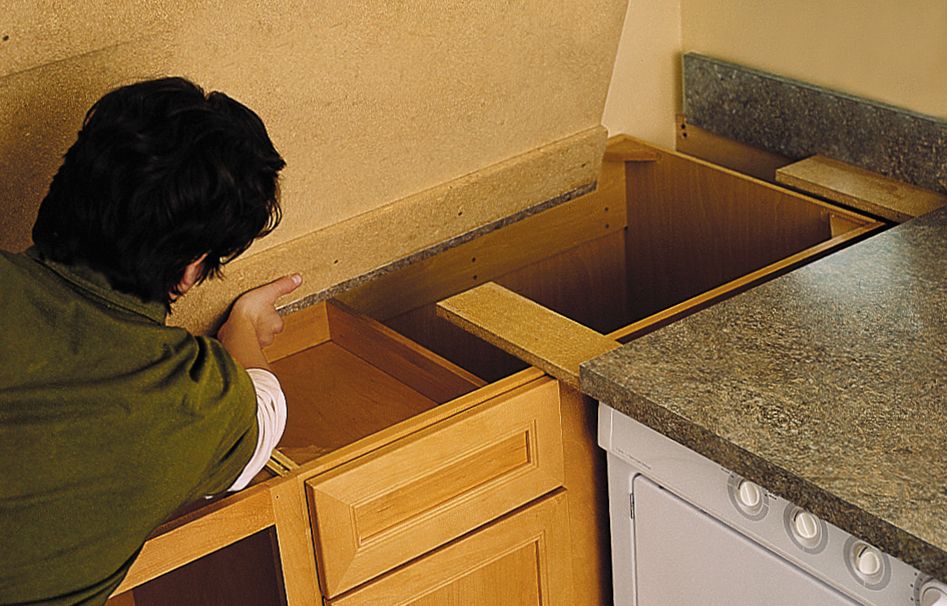
Dry-fit the countertop pieces. First lay down the piece with the extended strips, then fit the second piece on top.
Remove the counter. Run a bead of caulk along the cabinet tops and counter sides where the two pieces will meet.
Finish It Up
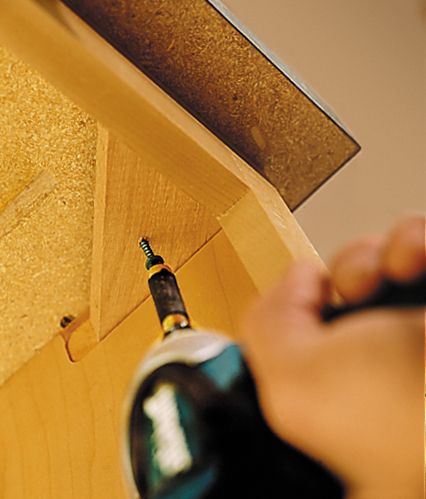
Lay the counter in place, and from inside the cabinet, drive 1 5/8-inch screws up through the mounting blocks in the cabinet corners and into the counter. Drive 1 1/4-inch screws through the extended strips to fasten the two sections together.
Use a wet finger to wipe away the caulk that squeezes out at the seam. This creates a smooth seal between the two pieces of laminate. Then, caulk and smooth wherever the countertop directly meets the wall for a finished look.
Troubleshooting Common Issues With a Laminate Countertop
Even with careful planning, issues can arise during installation. Here are solutions to common problems.
Dealing with Air Bubbles
If you notice air bubbles after adhering to the laminate, carefully lift the affected area and reapply pressure with the J-roller. For stubborn bubbles, you may need to inject additional adhesive using a syringe.
Fixing Misaligned Edges
If edges don’t align perfectly, use a file to carefully adjust the laminate. Work slowly and check your progress frequently to avoid over-filing.
Maintenance and Care for Laminate Counters
Good upkeep will keep your laminate countertop looking great for years.
Cleaning Tips
Clean your laminate countertop regularly with mild soap and water. Avoid abrasive cleaners or scrubbers that can scratch the surface. For tough stains, use a paste of baking soda and water, but test in an inconspicuous area first.
Preventing Damage
Use cutting boards to protect the surface from knife marks. Avoid placing hot pots or pans directly on the laminate, as this can cause discoloration or bubbling. Wipe up spills quickly to prevent staining or water damage.
Our Conclusion
Laminating a countertop is a great way to improve its look and usefulness. While it requires patience and attention to detail, it’s doable for most homeowners with basic DIY skills. Remember to work carefully when applying the laminate, as precision at this stage creates a professional-looking, long-lasting finish.
